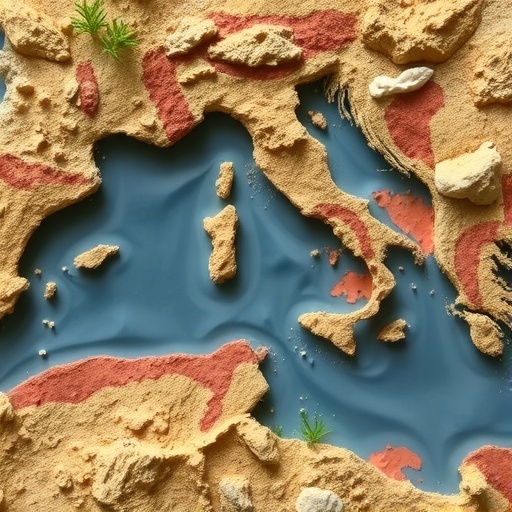
The ancient Phoenician civilization, renowned for its maritime prowess and cultural influence across the Mediterranean, has long been a subject of fascination for historians and archaeologists. Emerging from the Levantine coast, Phoenician traders and colonists established a network of settlements spanning from the eastern Mediterranean to North Africa and the western Mediterranean by the first millennium BCE. While their cultural and linguistic footprints are unmistakable, the genetic legacy of these ancient voyagers and settlers has remained enigmatic. A groundbreaking ancient DNA study now reveals that the genetic makeup of Punic populations—the descendants of Phoenician settlers in the central and western Mediterranean—bears surprisingly little resemblance to their Levantine homeland ancestors.
In a comprehensive genome-wide analysis, researchers examined 210 individuals sampled from 14 archeological sites traditionally associated with Phoenician and Punic presence. These sites spanned the Levant, North Africa, Iberian Peninsula, Sicily, Sardinia, and the Balearic Islands. By comparing genetic data from these individuals dating from the early Iron Age up to the second century BCE, the study elucidates the complex demographic processes that shaped the Punic world over several centuries.
The most striking revelation of the study is that genetic contributions from Levantine Phoenicians to Punic settlements in the central and western Mediterranean were minimal. Despite the substantial cultural, religious, and linguistic continuities documented archaeologically, the movement of people from the East appears to have been much less extensive than previously assumed. Instead, Punic communities derived the majority of their genetic ancestry from populations similar to those inhabiting Sicily and the wider Aegean region, indicating that local and regional populations played a dominant role in shaping the genetic landscape of Phoenician-descended communities west of the Levant.
This finding challenges a long-held narrative that presumed a large-scale migration of Levantine Phoenicians across the Mediterranean accompanying their mercantile and colonial ventures. The data suggests that Phoenician culture spread more through diffusion and integration into existing Mediterranean societies rather than by direct population replacement or mass demographic movement. It offers a nuanced perspective on how cultural identities and genetic ancestries can diverge within ancient populations.
Moreover, the study detected a significant North African genetic component in Punic populations, albeit as a minority contributor at all sites, including Carthage itself—Phoenicia’s most famous colony turned powerful city-state. This North African influence likely reflects the rising geopolitical and economic clout of Carthage, which emerged as a dominant force in the later periods of Punic history. The interplay of Mediterranean, North African, and local gene pools paints a picture of vibrant demographic interactions and exchanges.
Importantly, genetic diversity among Punic settlements was high, with no single dominant ancestry profile characterizing the region. This diversity attests to complex patterns of mobility, intermarriage, and population interaction across the Mediterranean basin, underscoring the Punic world as a hub of multicultural exchange rather than a monolithic demographic entity. The results also reveal genetic relationships that transcend local boundaries, connecting populations across distant sites, thereby mirroring the shared historical and economic networks documented by archaeologists.
The authors employed cutting-edge genomic techniques, including whole-genome sequencing and intricate population genetic modeling, enabling them to detect subtle ancestry components and demographic events invisible to traditional archaeological or historical methods. These technological advances facilitate a more precise reconstruction of ancient human movements and admixture processes, marking a new era in the study of Mediterranean prehistory.
Furthermore, the study’s multi-regional sampling strategy, encompassing both putative Phoenician heartlands and peripheral Punic settlements, provides an unprecedented resolution on how cultures and genes moved and mingled in antiquity. By incorporating data from burial contexts spanning various geographies and timeframes, the research integrates biological evidence with archaeological interpretations, fostering interdisciplinary insights.
Beyond its immediate historical implications, these findings have broader significance for understanding cultural diffusion and identity formation in ancient civilizations. The dissociation between cultural heritage and genetic ancestry in Phoenician-Punic populations exemplifies how cultural phenomena can propagate independently of large-scale human migrations. This paradigm challenges simplistic models of ethnicity and ancestry in the archaeological record.
Additionally, by highlighting the limited genetic imprint of Levantine migrants westward, the study prompts a reassessment of the mechanisms by which the Phoenician civilization expanded its influence. Economic networks, maritime trade, local alliances, and acculturation processes emerge as pivotal drivers, underscoring the dynamic and adaptive nature of ancient Mediterranean societies.
The research also provides new context for interpreting Punic archaeological sites characterized by heterogenous material culture and artistic expressions. The genetic heterogeneity unearthed by the study may explain the complex mosaic of cultural elements observed in Punic artifacts and urban layouts, reflecting a synthesis of diverse Mediterranean traditions.
Moreover, the relatively minor genetic contribution from Carthage itself across various sites calls into question assumptions about Carthage’s demographic dominance. Instead, it hints at a Punic world shaped by extensive local integration and regional demographic dynamics rather than colonial replacement or demographic hegemony.
This first robust genetic portrait of the Punic people opens novel avenues for future investigations into Mediterranean prehistory, such as exploring gene flow patterns linked to trade routes, examining genetic continuity or shifts during historical upheavals, and integrating genomic data with isotope analysis to infer mobility and diet.
In sum, the study revolutionizes our understanding of Phoenician and Punic demographic history. By demonstrating that Punic populations were genetically more Mediterranean and less Levantine than previously thought, it reframes historical perspectives on cultural transmission, migration, and identity in one of the most influential civilizations of the ancient world.
As science continues to merge genomics with archaeology, studies like this illuminate the intricate human narratives behind cultural phenomena. The Punic people, once viewed primarily through linguistic and material culture lenses, now emerge as a genetically diverse, interconnected group whose legacy resonates through the complexities of Mediterranean history.
Subject of Research:
Genetic ancestry and population history of Phoenician and Punic individuals across the Mediterranean during the first millennium BCE.
Article Title:
Punic people were genetically diverse with almost no Levantine ancestors.
Article References:
Ringbauer, H., Salman-Minkov, A., Regev, D. et al. Punic people were genetically diverse with almost no Levantine ancestors. Nature (2025). https://doi.org/10.1038/s41586-025-08913-3
Image Credits:
AI Generated
Tags: ancient DNA study findingsarchaeological genetic analysisgenetic diversity in ancient populationshistorical genetic connections in EuropeLevantine genetic legacymaritime influence of PhoeniciansMediterranean colonization patternsPhoenician civilization geneticsPhoenician cultural impactPunic ancestry researchPunic population demographicsPunic settlements in North Africa





